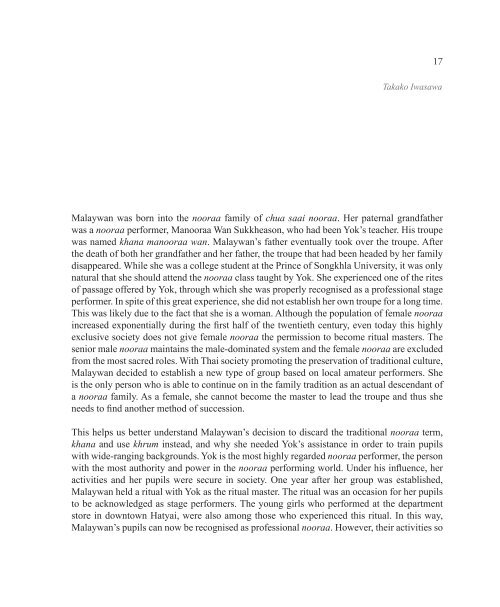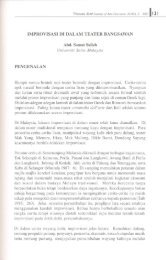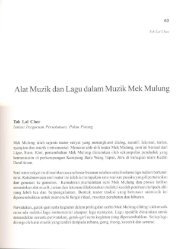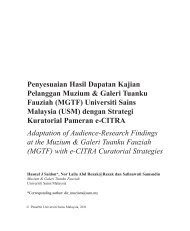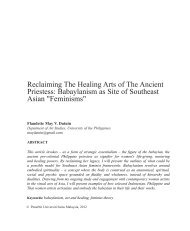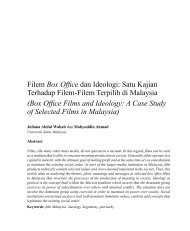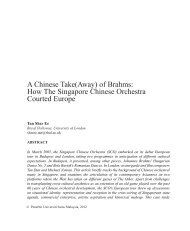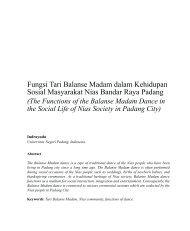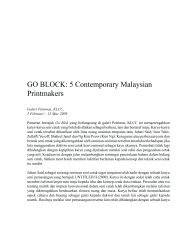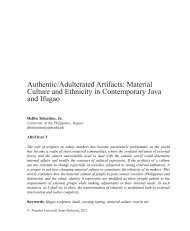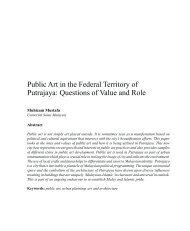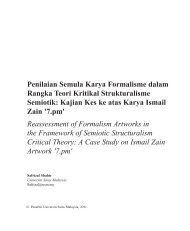Preservation of Traditional Art: The Case of the ... - Wacana Seni
Preservation of Traditional Art: The Case of the ... - Wacana Seni
Preservation of Traditional Art: The Case of the ... - Wacana Seni
Create successful ePaper yourself
Turn your PDF publications into a flip-book with our unique Google optimized e-Paper software.
17Takako IwasawaMalaywan was born into <strong>the</strong> nooraa family <strong>of</strong> chua saai nooraa. Her paternal grandfa<strong>the</strong>rwas a nooraa performer, Manooraa Wan Sukkheason, who had been Yok’s teacher. His troupewas named khana manooraa wan. Malaywan’s fa<strong>the</strong>r eventually took over <strong>the</strong> troupe. After<strong>the</strong> death <strong>of</strong> both her grandfa<strong>the</strong>r and her fa<strong>the</strong>r, <strong>the</strong> troupe that had been headed by her familydisappeared. While she was a college student at <strong>the</strong> Prince <strong>of</strong> Songkhla University, it was onlynatural that she should attend <strong>the</strong> nooraa class taught by Yok. She experienced one <strong>of</strong> <strong>the</strong> rites<strong>of</strong> passage <strong>of</strong>fered by Yok, through which she was properly recognised as a pr<strong>of</strong>essional stageperformer. In spite <strong>of</strong> this great experience, she did not establish her own troupe for a long time.This was likely due to <strong>the</strong> fact that she is a woman. Although <strong>the</strong> population <strong>of</strong> female nooraaincreased exponentially during <strong>the</strong> first half <strong>of</strong> <strong>the</strong> twentieth century, even today this highlyexclusive society does not give female nooraa <strong>the</strong> permission to become ritual masters. <strong>The</strong>senior male nooraa maintains <strong>the</strong> male-dominated system and <strong>the</strong> female nooraa are excludedfrom <strong>the</strong> most sacred roles. With Thai society promoting <strong>the</strong> preservation <strong>of</strong> traditional culture,Malaywan decided to establish a new type <strong>of</strong> group based on local amateur performers. Sheis <strong>the</strong> only person who is able to continue on in <strong>the</strong> family tradition as an actual descendant <strong>of</strong>a nooraa family. As a female, she cannot become <strong>the</strong> master to lead <strong>the</strong> troupe and thus sheneeds to find ano<strong>the</strong>r method <strong>of</strong> succession.This helps us better understand Malaywan’s decision to discard <strong>the</strong> traditional nooraa term,khana and use khrum instead, and why she needed Yok’s assistance in order to train pupilswith wide-ranging backgrounds. Yok is <strong>the</strong> most highly regarded nooraa performer, <strong>the</strong> personwith <strong>the</strong> most authority and power in <strong>the</strong> nooraa performing world. Under his influence, heractivities and her pupils were secure in society. One year after her group was established,Malaywan held a ritual with Yok as <strong>the</strong> ritual master. <strong>The</strong> ritual was an occasion for her pupilsto be acknowledged as stage performers. <strong>The</strong> young girls who performed at <strong>the</strong> departmentstore in downtown Hatyai, were also among those who experienced this ritual. In this way,Malaywan’s pupils can now be recognised as pr<strong>of</strong>essional nooraa. However, <strong>the</strong>ir activities so


